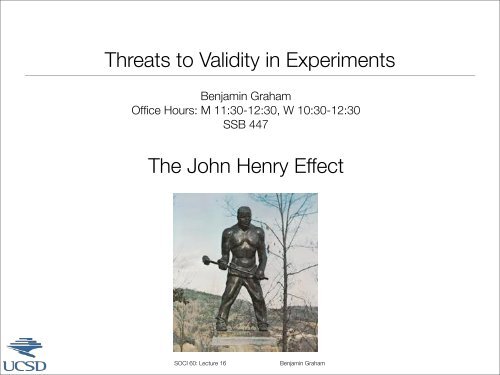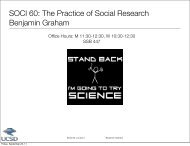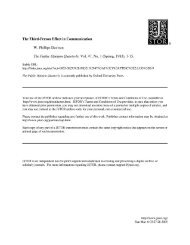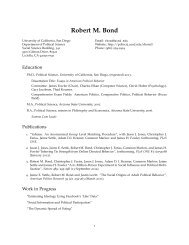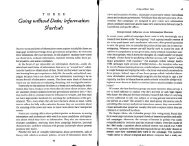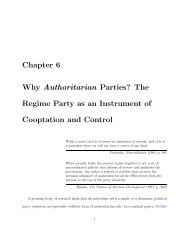Threats to Validity in Experiments The John Henry Effect
Threats to Validity in Experiments The John Henry Effect
Threats to Validity in Experiments The John Henry Effect
You also want an ePaper? Increase the reach of your titles
YUMPU automatically turns print PDFs into web optimized ePapers that Google loves.
<strong>Threats</strong> <strong>to</strong> <strong>Validity</strong> <strong>in</strong> <strong>Experiments</strong><br />
Benjam<strong>in</strong> Graham<br />
Office Hours: M 11:30-12:30, W 10:30-12:30<br />
SSB 447<br />
<strong>The</strong> <strong>John</strong> <strong>Henry</strong> <strong>Effect</strong><br />
SOCI 60: Lecture 16<br />
Benjam<strong>in</strong> Graham
Housekeep<strong>in</strong>g<br />
• No Class the Wednesday before Thanksgiv<strong>in</strong>g.<br />
• Midterm Nov. 7<br />
• Homework 3, now due Friday, Nov. 4 (Up on the site already)<br />
• Do part 2 of the homework at home, you should be able <strong>to</strong> complete all or<br />
most of part 1 dur<strong>in</strong>g section next week.<br />
• Midterm review guide #2 will be posted <strong>to</strong>night<br />
• No terms will be on the midterm that are not on the midterm review guides.
Sample midterm answer<br />
• Term: Ord<strong>in</strong>al Measure<br />
• Def<strong>in</strong>ition: A measure <strong>in</strong> which the values of the measure <strong>in</strong>dicate only the<br />
order of cases.<br />
• Significance: Ord<strong>in</strong>al measures allow “less than” or “greater than”<br />
comparisons, but the distance between po<strong>in</strong>ts on the scale may vary. <strong>The</strong><br />
distance between 1 and 2 on an ord<strong>in</strong>al scale may be different than the<br />
distance between 3 and 4 on the same scale. Ord<strong>in</strong>al measures conta<strong>in</strong> less<br />
<strong>in</strong>formation than ratio or <strong>in</strong>terval measures.<br />
• Example: If the concept be<strong>in</strong>g measured is annual <strong>in</strong>come, an ord<strong>in</strong>al scale<br />
could take a value of 0 for <strong>in</strong>comes less than $10,000 per year, a value of 1<br />
for <strong>in</strong>comes $10,000-25,000, and a value of 3 for <strong>in</strong>comes over $25,000 per<br />
year.<br />
SOCI 60: Lecture 16<br />
Benjam<strong>in</strong> Graham
Treatment = Independent Variable<br />
• Might be a dummy variable: Tu<strong>to</strong>r<strong>in</strong>g vs. No tu<strong>to</strong>r<strong>in</strong>g<br />
• Might be a ratio variable:<br />
• Number of Hours of Tu<strong>to</strong>r<strong>in</strong>g<br />
• Might be a categorical variable:<br />
• Noth<strong>in</strong>g vs. tu<strong>to</strong>r<strong>in</strong>g vs. onl<strong>in</strong>e study vs. lucky rabbits foot<br />
• Dummy variable means two groups: Treatment and Control<br />
• Other variable types will have multiple groups<br />
SOCI 60: Lecture 16<br />
Benjam<strong>in</strong> Graham
<strong>Threats</strong> <strong>to</strong> <strong>in</strong>ternal validity <strong>in</strong> experiments (1)<br />
• Selection bias (<strong>in</strong> assignment)<br />
• As soon as you set up a randomization, subjects go <strong>to</strong> work try<strong>in</strong>g <strong>to</strong> break it.<br />
• Ex: Progresa<br />
• Differential attrition<br />
• When people drop out of one group for different reasons than they drop out of the other.<br />
• Hypothesis: People beg<strong>in</strong> <strong>to</strong> like classical music if they listen <strong>to</strong> it all the time<br />
• Treatment group: Has <strong>to</strong> listen <strong>to</strong> classical music for 1 hour a day for a month<br />
• Control group: Listens <strong>to</strong> whatever music they want<br />
• Which group would experience more attrition? What type of people would drop out of the<br />
treatment group? How would that affect your f<strong>in</strong>d<strong>in</strong>gs?<br />
SOCI 60: Lecture 16<br />
Benjam<strong>in</strong> Graham
<strong>Threats</strong> <strong>to</strong> <strong>in</strong>ternal validity <strong>in</strong> experiments (2)<br />
• Endogenous change<br />
• Other events (besides the treatment) occur between pretest and post-test<br />
• Test<strong>in</strong>g: see the Solomon 4 group design<br />
• Maturation<br />
• Regression <strong>to</strong>ward the mean<br />
• Signal <strong>to</strong> noise ratio<br />
• His<strong>to</strong>ry <strong>Effect</strong>s/External Events<br />
• Not problems <strong>in</strong> true experiments <strong>in</strong> which the context for both groups is the<br />
same<br />
SOCI 60: Lecture 16<br />
Benjam<strong>in</strong> Graham
<strong>Threats</strong> <strong>to</strong> <strong>in</strong>ternal validity <strong>in</strong> experiments (3)<br />
• Contam<strong>in</strong>ation effects:<br />
• Diffusion<br />
• Particularly problematic where the treatment is some form of<br />
<strong>in</strong>formation or education<br />
• Demoralization<br />
• Compensa<strong>to</strong>ry rivalry: AKA the <strong>John</strong> <strong>Henry</strong> <strong>Effect</strong><br />
SOCI 60: Lecture 16<br />
Benjam<strong>in</strong> Graham
<strong>Threats</strong> <strong>to</strong> <strong>in</strong>ternal validity <strong>in</strong> experiments (4)<br />
• Treatment misidentification: <strong>The</strong> treatment isn’t what we th<strong>in</strong>k it is<br />
• Hawthorne effect: What did researchers th<strong>in</strong>k the treatment was? What else was<br />
part of the “treatment”?<br />
• Experimenter expectations: <strong>The</strong> need (<strong>in</strong> some cases) for double-bl<strong>in</strong>d experiments<br />
• Voter education <strong>in</strong> Georgia (the country)<br />
• Villages are randomly assigned <strong>to</strong> treatment and control<br />
• “Educa<strong>to</strong>rs” go door <strong>to</strong> door <strong>in</strong> the treatment group villages and provide residents<br />
with <strong>in</strong>formation on the election date, the issues, and the candidates.<br />
• No one goes door <strong>to</strong> door <strong>in</strong> the villages <strong>in</strong> the control group.<br />
• Results: Treatment villages experience lower voter turnout than the control villages.<br />
• What did researchers th<strong>in</strong>k the treatment was?<br />
• What else might have been part of the “treatment”, and how might this have<br />
negatively affected voter turnout?<br />
SOCI 60: Lecture 16<br />
Benjam<strong>in</strong> Graham
Selection bias <strong>in</strong> sampl<strong>in</strong>g<br />
• Experimenters often overstate the external validity of their results<br />
• Experiment participants are rarely a true random sample of the population<br />
• Key question: How do people who are will<strong>in</strong>g <strong>to</strong> participate <strong>in</strong> the study differ<br />
from those who are unwill<strong>in</strong>g <strong>to</strong> participate?<br />
SOCI 60: Lecture 16<br />
Benjam<strong>in</strong> Graham
Non-experimental methods<br />
• Rem<strong>in</strong>d me why we can’t make good causal <strong>in</strong>ference with a simple crosssectional<br />
study?<br />
• What are these k<strong>in</strong>d of studies good for?<br />
SOCI 60: Lecture 16<br />
Benjam<strong>in</strong> Graham


